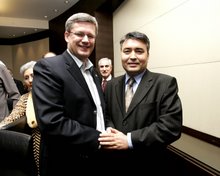On "Free the Uyghurs"
By James Millward
I never thought I’d see “Free the Uighurs” on the editorial pages of major U.S. newspapers, but there it was last Thursday in the Washington Post (Editorial, February 19, 2009, p. A14) and Monday in the Los Angeles Times (Editorial, Feb. 23, 2009). Of course, the editorial was not discussing Uyghurs in China, but the seventeen Uyghur detainees at Guantanamo, whom a federal appeals court ruled could be brought to the U.S. only by an act of the executive branch, not the courts. The Post urged the Obama administration to do the right thing by these men, whom the Bush administration acknowledged years ago were not “enemy combatants” but whom it could neither send back to China nor find a third country willing to take.
It was not that long ago that references to Uyghurs hardly ever appeared in the international press. From the late 1980s through the late 1990s there were occasional stories, when reporters given rare opportunities to travel to Xinjiang sought out silk road exotica and separatism—story lines they seem to have settled on before their trip. It was not hard to flesh out the template with colorful minority clothing, mutton kabobs and some young guy in the bazaar complaining about the Chinese. The rare actual violent incidents were exciting—they fit the imagined narrative that Xinjiang was a “simmering cauldron” or “powder-keg waiting to blow.” But they were harder to write about, as information was scant and mainly filtered through PRC state media, which was then intent on minimizing any local unrest or dissent. Internally, in the late 1990s Xinjiang Party officials still worried about the Xinjiang issue becoming “internationalized”—in other words, emerging, like Tibet, as a global cause célèbre.
After September 11th, 2001, China abruptly reversed course, deliberately publicizing the issue of Uyghur dissent as “terrorism, separatism and religious extremism,” and explicitly linking potential unrest in Xinjiang (the region was in fact quiet from 1997 through 2008) to Al Qaeda and the U.S. “global war on terror.” This linkage was accomplished through a document issued in English by the State Council in January 2002, official press reports, and print and broadcast interviews with Chinese leaders. The message was much reiterated in subsequent years; state media and PRC leaders proclaimed Uyghurs to be the main potential security risk to the 2008 Olympics (in the spring before and during the Olympics, there were in fact three incidents of what seems to have been politically-inspired violence involving Uyghurs in Xinjiang.)
The U.S. government, international media and anti-terrorism think-tanks contributed to the re-branding of Uyghur dissent as a “movement” motivated by Islamist thinking and linked to “international terror organizations.” Stereotyped notions about Islam and a paucity of solid firsthand information about Xinjiang made plausible the idea that Al Qaeda-type Uyghur jihadis were “waging” a “militant” “resistance” against Chinese authorities, even in absence of anything like a terrorist attack for over a decade. Because every “movement” needs an acronym, concerns crystallized around ETIM (East Turkestan Islamic Movement), one of several groups mentioned in the Chinese State Council document. The U.S. listed ETIM as an international terrorist organization in 2002 and mistakenly attributed to it all the violent acts reported by the PRC as having occurred in Xinjiang for the ten years prior to 1997, though Chinese sources themselves up to that point had not attributed any specific acts to ETIM (they did so subsequently). The U.S. thus made ETIM the name to conjure with.[1]
Now the “Uyghur issue” is well and truly internationalized, thanks to U.S. and Chinese policies and rhetoric over the past several years. Indeed, at the moment it stands at the crux of U.S.-Chinese relations. In order to close down Guantanamo prison, as President Obama has pledged, detainees who cannot be repatriated must be resettled elsewhere. In order to convince third countries to accept Guantanamo detainees, the U.S. must first show willingness to resettle some itself. Politically, the Uyghurs are the easiest choice among the detainees for U.S. asylum: they were determined by the Bush administration to harbor “no animus” towards the United States; there is a measure of Congressional support for their resettlement thanks in part to effective lobbying efforts by the Uyghur America Association (itself funded by the U.S. government through the National Endowment for Democracy); and the Uyghur community here is eager to help in the detainees’ transition.
Of course, the PRC government strongly opposes resettling Uyghurs from Guantanamo in the U.S. or anywhere else, and wants them sent back to China. As Li Wei, from the China Institute of Contemporary International Relations, put it in an interview with NPR’s Anthony Kuhn (Morning Edition, Feb. 20, 2009), “what would the American government think if China sheltered people who threatened America's national security?” Li makes a reasonable point: if China publicly resettled Al Qaeda trainees from Afghan camps, the U.S. would take this as a major affront.
So now, with the Obama-era U.S.-China relationship still unformed, an act critical to realizing the president’s promise to shut down Guantanamo will also, like it or not, be seen as his major first act related to China: granting asylum to a group of men China has repeatedly and publicly denounced as violent terrorist members of ETIM. The Chinese public and most Chinese academics, party-members and officials sincerely believe Uyghur terrorists pose a grave security threat to China. ETIM is their Al Qaeda.
Moreover, despite the fact that no country and no serious scholar disputes the legality of China’s sovereignty in Xinjiang, some Chinese believe the U.S. supports and foments Uyghur terrorism in order to destabilize China. American academics who write about Xinjiang have been (falsely) accused in Chinese publications of working with the U.S. government to provide “a theoretical basis for one day taking action to dismember China and separate Xinjiang” (Pan Zhiping, in his introduction to the internal Chinese translation of Frederick Starr, ed. Xinjiang: China's Muslim Frontier). We should not underestimate the perception gap between the U.S. and China over Xinjiang and the Uyghurs. In China, the issue is as radioactive as the sands of Lop Nor.
Thus, while the U.S. press has discussed the Guantanamo Uyghurs mainly as a domestic U.S. political and legal issue, their fate could have a great impact on U.S.-China relations at this critical time. The legacy of the Bush administration’s China policy is often treated as broadly positive, thanks to the role played by Treasury Secretary Henry Paulson and resultant stress on economic affairs. However, the Guantanamo Uyghurs are another huge mess Bush got us into. Thanks to Bush-era mistakes and the fuzzy but dangerous notion of “global war on terror,” the Obama administration faces yet another potential crisis—one in U.S.-China relations—right off the bat.
The U.S. should recognize that while resettling the seventeen Uyghurs here may be the only way to break the Guantanamo log-jam, to do so will mean asking China to swallow something extremely unpalatable. If a blow-up in U.S.-China relations can be averted, it will be because American diplomats handle the issue with the extreme sensitivity it merits, and because China chooses to overlook U.S. hypocrisy and place the greater interests of good Sino-U.S. ties over their entrenched rhetorical position on Xinjiang. In so doing they will help us put yet another Bush-era disaster behind us and move on.
Wednesday, February 25, 2009
Subscribe to:
Post Comments (Atom)






No comments:
Post a Comment